


11/09/2013
FEATURE BY MATT SOMERFIELD
The Formula One circus headed into the last European race of the season knowing that the circuit represents a unique challenge. The 3.6 mile Autodromo Nazionale Monza is nestled in parkland and represents a unique challenge for both teams and drivers with only chicanes and a few medium downforce corners breaking up the long, super-fast straights. It therefore comes as no surprise that many teams have Monza specific parts to cater for this low downforce circuit. As I discussed in my previous roundup (Spa) some of the teams took the time to simulate their extremely low downforce rear wing configurations during the free practice sessions.
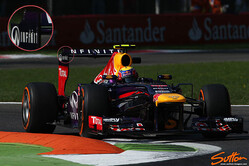 Red Bull
Red Bull
With neither of its drivers completing the Italian GP in 2012 the team was eager to continue its current momentum and take a result in Ferrari's back yard.
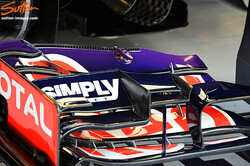 The team arrived with the same low downforce rear wing it had tested in Spa featuring endplates devoid of the louvres we usually see that reduce drag. Louvres aren't really required when you are running a shallow 'angle of attack' like Red Bull used at Monza as the drag penalty is severely minimized.
The team arrived with the same low downforce rear wing it had tested in Spa featuring endplates devoid of the louvres we usually see that reduce drag. Louvres aren't really required when you are running a shallow 'angle of attack' like Red Bull used at Monza as the drag penalty is severely minimized.
Red Bull started the weekend with its regular front wing featuring the main cascades but was devoid of the small strakes we have seen added to the front of the wing over the last few races in order to guide airflow to the rearward strakes, further minimising drag.
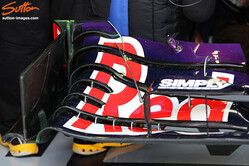 However as the weekend developed and it became apparent that other teams were sacrificing their cascades (used to turn the airflow outbound and over the front wheels), Red Bull also decided to run without them. Interestingly we can also see the team started to trim the level of downforce the front wing was producing also, curtailing the top flap's height (left of the adjuster) and removing the gurney trim completely.
However as the weekend developed and it became apparent that other teams were sacrificing their cascades (used to turn the airflow outbound and over the front wheels), Red Bull also decided to run without them. Interestingly we can also see the team started to trim the level of downforce the front wing was producing also, curtailing the top flap's height (left of the adjuster) and removing the gurney trim completely.
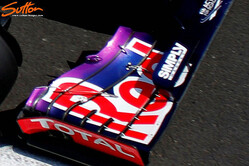 Meanwhile for qualifying and the race Webber's side of the garage went one stage further taking a further few millimetres off the inboard edge of the top flap, further reducing the force being created by the wing.
Meanwhile for qualifying and the race Webber's side of the garage went one stage further taking a further few millimetres off the inboard edge of the top flap, further reducing the force being created by the wing.
Ferrari
The team element of the sport is often overlooked by the fans but Ferrari know only too well that it needed a good result on home turf to accelerate away from Mercedes in the battle for what will surely be second place in the Constructors' Championship.
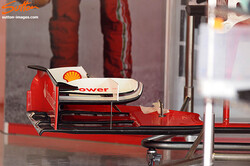 The team arrived with two iterations of front wing the first featured the main cascade used for the last few races but used a singular top flap design (albeit not shown in this image)
The team arrived with two iterations of front wing the first featured the main cascade used for the last few races but used a singular top flap design (albeit not shown in this image)
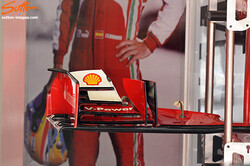 Whilst the newer wing featured a cascade-less arrangement, two vertical vortex generating fins were added to control the airflow around the front wheels.
Whilst the newer wing featured a cascade-less arrangement, two vertical vortex generating fins were added to control the airflow around the front wheels.
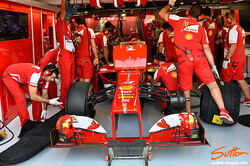 As we can see here, when the large top flap was added the team decided not to cut away the upper section of the flap like they did in Spa
As we can see here, when the large top flap was added the team decided not to cut away the upper section of the flap like they did in Spa
Prior to the change back to the 2012 construction Pirelli tyres a little earlier in the season, Ferrari had been working on extension of the bodywork around the exhaust (see the difference in length in the black section of bodywork behind the UPS logo) and new curved airflow conditioners that met with the side of the cockpit to enhance the downwash airflow toward the exhaust.
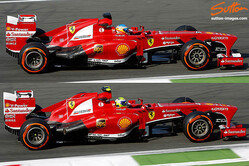 Since then the team has reverted to the shorter sidepods and vertical airflow conditioners. In free practice at Monza the team once again assessed the longer bodywork although this time it retained the vertical flow conditioners. Its simulation work obviously shows the two packages are quite close in terms of performance with the splash zone of the exhaust plume and cross-under of the airflow beneath the Semi-Coanda exhaust giving differing results dependent on the application. The team did however decide to run with the shorter bodywork for the rest of the weekend.
Since then the team has reverted to the shorter sidepods and vertical airflow conditioners. In free practice at Monza the team once again assessed the longer bodywork although this time it retained the vertical flow conditioners. Its simulation work obviously shows the two packages are quite close in terms of performance with the splash zone of the exhaust plume and cross-under of the airflow beneath the Semi-Coanda exhaust giving differing results dependent on the application. The team did however decide to run with the shorter bodywork for the rest of the weekend.
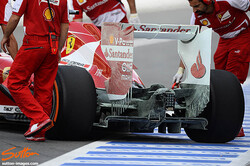 Lastly at the rear of the car the team ran the rear wing without the trailing edge slats for the first time this season which alludes to the generation of additional aspect ratio and therefore downforce that's not required for Monza. Furthermore the wing bore resemblance to the one tested in free practice at Spa with a much shallower 'angle of attack'. Other alterations to the endplates included using only a singular drag reducing louvre whilst the tyre wake slots used at Silverstone and subsequently abandoned were once again added to the leading edge.
Lastly at the rear of the car the team ran the rear wing without the trailing edge slats for the first time this season which alludes to the generation of additional aspect ratio and therefore downforce that's not required for Monza. Furthermore the wing bore resemblance to the one tested in free practice at Spa with a much shallower 'angle of attack'. Other alterations to the endplates included using only a singular drag reducing louvre whilst the tyre wake slots used at Silverstone and subsequently abandoned were once again added to the leading edge.
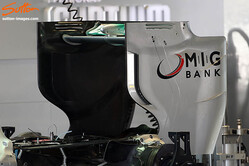 Mercedes
Mercedes
With the exception of Spa, Mercedes could have been considered the team to beat in the speed traps ahead of the weekend. Not resting on its laurels though the team had an entirely new rear wing for Monza.
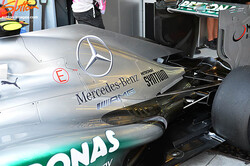 This new rear wing also features a shallow angle of attack but returns to a more conventional mainplane and top flap design than the Spa counterpart. The wing's endplates were also treated to several revisions with the louvres moved back from their usual leading edge position and their number reduced to two. Whilst the tyre wake slots used to distribute the pressure created at the endplates introduced a few races ago were also enlarged significantly. The team however did retain the skewed horizontal trailing edge strakes added at Spa to control potential vortices spilling off the endplate.
This new rear wing also features a shallow angle of attack but returns to a more conventional mainplane and top flap design than the Spa counterpart. The wing's endplates were also treated to several revisions with the louvres moved back from their usual leading edge position and their number reduced to two. Whilst the tyre wake slots used to distribute the pressure created at the endplates introduced a few races ago were also enlarged significantly. The team however did retain the skewed horizontal trailing edge strakes added at Spa to control potential vortices spilling off the endplate.
As we can see here the team also added a new beam wing design which works on creating downforce centrally and reducing drag at its outer portion.
Lotus
The DNF for Kimi at Spa had almost certainly put paid to his title aspirations but a good result at Monza could at least swing the momentum back his way for a charge to the end.
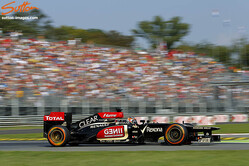 The team was originally scheduled to use its new long wheelbase chassis at Spa but instead took the car to Monza where only Kimi would assess its credentials. Having used the LWB E21 for free practice 1 and 2 the Finn returned to the standard wheelbase E21 for qualifying and the race but the team has reported both drivers will use the new chassis from Singapore onwards. The desire to change chassis length comes from feedback given in their simulation work and this is why I find it hard to swallow that Kimi does this kind of track testing for the team as he does little of the simulation work. The longer wheel base car has been introduced to cater for several area's the team feels it will gain an advantage from. Pushing some of the suspension elements around 100mm further forward allows not only for more adjustment but will alter the airflow characteristics also. Furthermore, to meet with the dimensional restrictions in that area a longer nose and splitter section will need to be applied altering how the car behaves aerodynamically and hopefully have a positive impact on other area's downstream. New crash tests will have been completed in order to race the new chassis which obviously increases Lotus' costs.
The team was originally scheduled to use its new long wheelbase chassis at Spa but instead took the car to Monza where only Kimi would assess its credentials. Having used the LWB E21 for free practice 1 and 2 the Finn returned to the standard wheelbase E21 for qualifying and the race but the team has reported both drivers will use the new chassis from Singapore onwards. The desire to change chassis length comes from feedback given in their simulation work and this is why I find it hard to swallow that Kimi does this kind of track testing for the team as he does little of the simulation work. The longer wheel base car has been introduced to cater for several area's the team feels it will gain an advantage from. Pushing some of the suspension elements around 100mm further forward allows not only for more adjustment but will alter the airflow characteristics also. Furthermore, to meet with the dimensional restrictions in that area a longer nose and splitter section will need to be applied altering how the car behaves aerodynamically and hopefully have a positive impact on other area's downstream. New crash tests will have been completed in order to race the new chassis which obviously increases Lotus' costs.
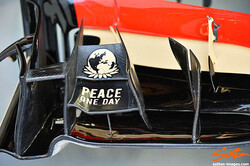 However finding these types of gains both aerodynamically and mechanically without such drastic action mid-season is almost impossible and will likely help in its 2014 plans too. Furthermore the chassis is an area that is generally built with bloat, i.e. more weight than is necessary and as the team creates additional parts throughout the season and wants to keep the car close to the target weight, it will skim weight from the chassis. When designing its new chassis the team will perhaps have been able to trim some of the fat from the edges also.
However finding these types of gains both aerodynamically and mechanically without such drastic action mid-season is almost impossible and will likely help in its 2014 plans too. Furthermore the chassis is an area that is generally built with bloat, i.e. more weight than is necessary and as the team creates additional parts throughout the season and wants to keep the car close to the target weight, it will skim weight from the chassis. When designing its new chassis the team will perhaps have been able to trim some of the fat from the edges also.
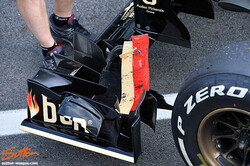 Like the other teams Lotus also arrived with a new front and rear wing with the former featuring a re-designed cascade arrangement. The smaller cascade finds itself offset from the endplate by virtue of a horizontal blade.
Like the other teams Lotus also arrived with a new front and rear wing with the former featuring a re-designed cascade arrangement. The smaller cascade finds itself offset from the endplate by virtue of a horizontal blade.
Furthermore we find that the drooping vane which protrudes outbound of the endplate now also features a slot.
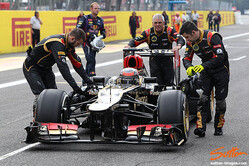 The usual nose that features the use of the 'Pelican' style underbelly was absent for Monza and with this the team also moved the FOM cameras into the more neutral position at the side of the nose. (Normally situated between the front wing's pylons)
The usual nose that features the use of the 'Pelican' style underbelly was absent for Monza and with this the team also moved the FOM cameras into the more neutral position at the side of the nose. (Normally situated between the front wing's pylons)
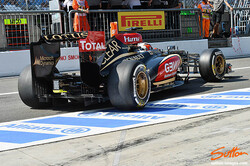 The rear wing was also given the low downforce treatment with a much shallower angle of attack / reduced chord length whilst the endplates were devoid of louvres.
The rear wing was also given the low downforce treatment with a much shallower angle of attack / reduced chord length whilst the endplates were devoid of louvres.
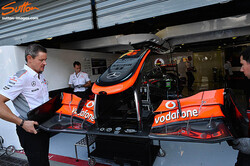 McLaren
McLaren
Having now ousted Force India from fifth place the team knows it is not fighting for the championships and is instead focusing on maintaining the gap.
Like many of the other teams we find the front wing takes the cascade-less approach whilst the top flap has also been trimmed away to reduce the force it generates.
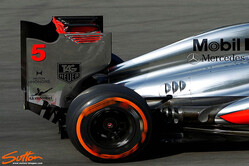 At the rear of the car we see the team has added some additional cooling slots into the lower section of the engine cover whilst the lower downforce rear wing used at Spa sees further amendments to the endplate with the tyre wake slots the team has used over the last few races being deleted.
At the rear of the car we see the team has added some additional cooling slots into the lower section of the engine cover whilst the lower downforce rear wing used at Spa sees further amendments to the endplate with the tyre wake slots the team has used over the last few races being deleted.
Learn more about Matt and check out his previous features, here